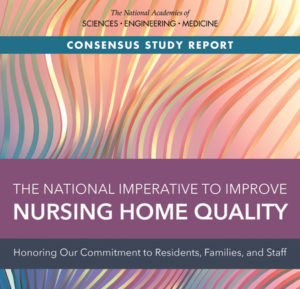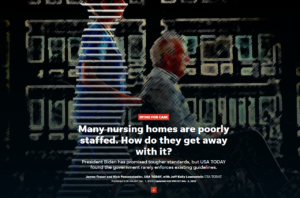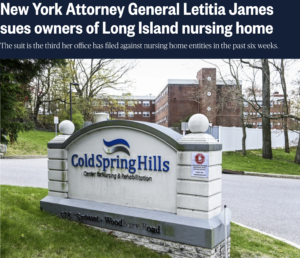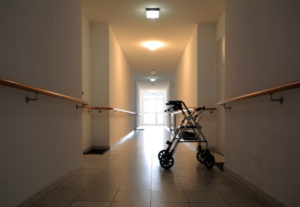2022 has been a pivotal year in long-term care and we at LTCCC are grateful for all those who have been writing and reporting about the important issues along the way.
That’s why we’re sharing 22 of our favorite articles of 2022 (plus, a few extras!). Below is a list of investigative stories, government reports, and other articles about nursing home reform, finances, staffing, oversight, equity, dementia care, and more. Click the toggle (+) for excerpts and follow the link for the full articles.
Note: The list is neither comprehensive nor in order of ranking. There have been many excellent reports on long-term care in 2022, but you won’t find all of them on this page — sorry if we missed you!
Reform
“The President believes we must improve the quality of our nursing homes so that seniors, people with disabilities, and others living in nursing homes get the reliable, high-quality care they deserve. That’s why he is announcing a set of reforms—developed by and implemented through the Department of Health and Human Services (HHS)—that will improve the safety and quality of nursing home care, hold nursing homes accountable for the care they provide, and make the quality of care and facility ownership more transparent so that potential residents and their loved ones can make informed decisions about care.”
The White House, “FACT SHEET: Protecting Seniors by Improving Safety and Quality of Care in the Nation’s Nursing Homes.” Available at https://www.whitehouse.gov/briefing-room/statements-releases/2022/02/28/fact-sheet-protecting-seniors-and-people-with-disabilities-by-improving-safety-and-quality-of-care-in-the-nations-nursing-homes/.
“This report identifies critical opportunities to improve the quality of care in nursing homes through both short- and long-term actions across a wide variety of domains. Many recommendations will require dedicated coordination among federal and state governments, nursing homes, health care and social care providers, payers, regulators, researchers, and others as well as the active engagement of residents and their families.”
National Academies of Sciences, Engineering, and Medicine, The Committee on the Quality of Care in Nursing Homes, “The National Imperative to Improve Nursing Home Quality: Honoring Our Commitment to Residents, Families, and Staff.” Available at https://www.nationalacademies.org/our-work/the-quality-of-care-in-nursing-homes.
“What AHCA objects to in President Biden’s nursing home reform agenda is enforcement – being held accountable for actually meeting federal standards of care for residents. AHCA supports reimbursement for facilities, but it opposes fines or other financial consequences when facilities fail to meet federal care standards.”
Center for Medicare Advocacy, Edelman, T., “What Does AHCA Object to In The Biden Nursing Home Reform Agenda? Being Held Accountable for Care.” Available at https://medicareadvocacy.org/what-does-ahca-object-to-in-the-biden-nursing-home-reform-agenda-being-held-accountable-for-care/.

The National Imperative to Improve Nursing Home Quality, NASEM
Finances
“Half of all Americans now die in hospice care. Easy money and a lack of regulation transformed a crusade to provide death with dignity into an industry rife with fraud and exploitation.”
ProPublica, Kofman, A., “Endgame: How the Visionary Hospice Movement Became a For-Profit Hustle.” Available at https://www.propublica.org/article/hospice-healthcare-aseracare-medicare.
“On average, for-profit nursing homes doing business with related companies spent less on staffing and received lower federal quality ratings than not-for-profit or government-owned facilities. However, they spent more on staffing and received higher quality ratings than for-profit homes with no related-company business.”
Empire Center, Hammond, B., “Following the Money: An analysis of ‘related company’ transactions in New York’s nursing home industry.” Available at https://www.empirecenter.org/publications/following-the-money-2/.
“As nursing homes continue to ask for more reimbursement, a number of states have begun to question more directly how facilities spend the reimbursement they already receive, with some states enacting legislation to require more transparency and accountability. Questions are also raised about how facilities have spent the many additional billions of dollars they received, and continue to receive, from federal and state governments during the coronavirus pandemic.”
Center for Medicare Advocacy, Edelman, T., “How Do Nursing Homes Spend the Reimbursement They Receive for Care?” Available at https://medicareadvocacy.org/how-nursing-homes-spend-public-money/.
“Nearly a quarter of the hundred-person staff had been with the home for more than fifteen years; the activities director was in her forty-fifth year. But the ownership change precipitated a mass exodus. Within two weeks, management laid out plans to significantly cut back nurse staffing. Some mornings, there were only two nursing aides working at the seventy-two-bed facility. A nurse at the home, who spoke on condition of anonymity for fear of retribution, told me, “It takes two people just to take some residents to the bathroom.””
The New Yorker, Rafiei, Y., “When Private Equity Takes Over a Nursing Home.” Available at https://www.newyorker.com/news/dispatch/when-private-equity-takes-over-a-nursing-home.

When Private Equity Takes Over a Nursing Home, The New Yorker
Staffing
“The new data revealed nursing homes, on average, experienced turnover of 52% of nursing staff each year. In other words, the average nursing facility has to replace half of its direct care staff each year. These dismal numbers come at a time where the nursing home industry claims it is in the midst of a staffing crisis, unable to find workers to fill jobs. These turnover numbers, however, tell a different story-one of poor job quality. Numerous studies have shown that nursing turnover is related to poor pay, lack of benefits, high workloads, inadequate training, poor management, and lack of career advancement. Most importantly, high turnover means poorer health outcomes for nursing home residents.”
The National Consumer Voice for Quality Long-Term Care, “High Staff Turnover: A Job Quality Crisis in Nursing Homes.” Available at https://theconsumervoice.org/uploads/files/issues/High_Staff_Turnover-A_Job_Quality_Crisis_in_Nursing_Homes.pdf.
“[T]he major national nursing home trade association admits that the overwhelming majority of nursing facilities in the country do not have enough staff to meet a standard that was recognized more than 20 years ago as the minimum staffing level needed to provide residents with appropriate care. Clearly, more nursing staff are necessary in 2022 to meet the greater health care needs of today’s nursing home residents. AHCA, however, argues that meeting the 20+-year old staffing standard would require hiring 187,000 nurses and nurse aides, at a cost $10 billion a year. Even if that estimate were true, $10 billion is just over 5% of the $196.8 billion in national nursing home expenditures in 2020.”
Center for Medicare Advocacy, Edelman, T., “Improving Nursing Home Staffing Levels Can And Must Be Done.” Available at https://medicareadvocacy.org/nursing-home-staffing-levels/.
“Regulators have allowed thousands of nursing homes across America to flout federal staffing rules by going an entire day and night without a registered nurse on duty, a USA TODAY investigation has found. Nearly all of them got away with it: Only 4% were cited by government inspectors. Even fewer were fined.”
USA Today, Fraser, J., and Penzenstadler, N., “Many nursing homes are poorly staffed. How do they get away with it?” Available at https://www.usatoday.com/in-depth/news/investigations/2022/12/01/skilled-nursing-facilities-staffing-problems-biden-reforms/8318780001/.

Many nursing homes are poor staffed, USA Today
Oversight
“New York Attorney General Letitia James today filed a lawsuit against Comprehensive at Orleans LLC doing business as The Villages of Orleans Health and Rehabilitation Center (The Villages), a nursing home in Albion, New York, for years of financial fraud that resulted in significant resident neglect and harm. Following an extensive investigation conducted by the Office of the Attorney General (OAG), the lawsuit — filed against the owners, operators, and related companies (owners) — demonstrates how the owners took advantage of the state’s Medicaid program to increase their personal profits, rather than use those funds for the intended purposes of staffing and patient care.”
New York State Office of the Attorney General, “Attorney General James Sues Orleans County Nursing Home for Years of Fraud and Resident Neglect.” Available at https://ag.ny.gov/press-release/2022/attorney-general-james-sues-orleans-county-nursing-home-years-fraud-and-resident.
“New York Attorney General Letitia James today filed a lawsuit against Cold Spring Hills Center for Nursing and Rehabilitation (Cold Spring Hills), a Nassau County nursing home, its related businesses, their owners, and senior managers, for years of financial fraud and self-dealing that led to severe understaffing and resident neglect and harm. An investigation by the Office of the Attorney General (OAG) found that Cold Spring Hills’ owners diverted over $22.6 million in Medicaid and Medicare funds from resident care through a fraudulent network of companies that were used to conceal up-front profit taking. The lawsuit alleges that long before the COVID-19 pandemic, the owners repeatedly cut staffing at the 588-bed facility, which created poor working conditions and endangered residents.”
New York State Office of the Attorney General, “Attorney General James Sues Long Island Nursing Home for Years of Fraud and Resident Neglect.” Available at https://ag.ny.gov/press-release/2022/attorney-general-james-sues-long-island-nursing-home-years-fraud-and-resident.
“Implementing proper infection prevention and control practices can be critical for preventing the spread of infectious diseases. Infection prevention and control has been a long-standing concern in the nation’s more than 15,000 nursing homes—one that the COVID-19 pandemic has brought into sharper focus. Some infection prevention and control practices in nursing homes, such as social isolation, may negatively affect resident mental and physical health.”
U.S. Government Accountability Office, “COVID-19 in Nursing Homes: CMS Needs to Continue to Strengthen Oversight of Infection Prevention and Control.” Available at https://www.gao.gov/products/gao-22-105133.
“The pandemic was devastating and deadly for New Yorkers living in nursing homes. Families have a right to know if their loved one’s COVID-19 death was counted, but many still don’t have answers from the state Department of Health,” DiNapoli said. “Our audit findings are extremely troubling. The public was misled by those at the highest level of state government through distortion and suppression of the facts when New Yorkers deserved the truth. The pandemic is not over, and I am hopeful the current administration will make changes to improve accountability and protect lives. An important step would be for DOH to provide the families who lost loved ones with answers as to the actual number of nursing homes residents who died. These families are still grieving, and they deserve no less.”
Office of the New York State Comptroller, “State’s Pandemic Response to Nursing Homes Hindered by Ill-Prepared State Agency.” Available at https://www.osc.state.ny.us/press/releases/2022/03/dinapoli-states-pandemic-response-nursing-homes-hindered-ill-prepared-state-agency.
“OIG found 1,714 providers whose telehealth billing practices pose a high risk to Medicare. Those providers billed for telehealth services for about half a million beneficiaries amounting to $127.7 million in Medicare payments.”
Center for Medicare Advocacy, St. John, C., “OIG Report: Telehealth Services Need Targeted Oversight to Safeguard Medicare.” Available at https://medicareadvocacy.org/oig-report-telehealth-services-need-targeted-oversight-to-safeguard-medicare/.

New York Attorney General Letitia James sues owners of Long Island nursing home, NBC News
Equity
“The quality of care people receive once they are given a life-threatening diagnosis or as they approach the end of their life depends upon race, ethnicity, socioeconomic status, and who they love. Such disparities in treatment are unconscionable and must be addressed. They warrant serious attention from policymakers and clinicians as well as focused efforts to find solutions.”
American Society on Aging, Ryerson, L. M., “Prioritizing Health Equity in Palliative and End-of-Life Care.” Available at https://generations.asaging.org/health-equity-palliative-and-end-life-care.
“Numerous studies have found harmful disparities in the nursing facility care received by residents of color. Now is the time to target and reverse these disparities. Eliminating partial Medicaid certification and increasing staffing levels would benefit residents of all racial backgrounds, with especial benefit to residents of color. Increased cultural competency, along with training in implicit bias, would improve both quality of care and quality of life for residents of color. Finally, HCBS improvements would better enable residents of all racial backgrounds to receive necessary care outside of nursing facilities, which would particularly benefit older adults of color, who are more likely otherwise to reside in low quality nursing facilities.”
Justice in Aging, Carlson, E., and Selassie, G., “Racial Disparities in Nursing Facilities—and How to Address Them.” Available at https://justiceinaging.org/wp-content/uploads/2022/09/Racial-Disparities-in-Nursing-Facilities.pdf.
“We’re twice as likely as our straight counterparts to be single and live alone, which means more likely to be isolated and lonely. We’re four times less likely to have children. We’re more likely to face poverty and homelessness, and to have poor physical and mental health. Many of us report delaying or avoiding necessary medical care because we face discrimination or mistreatment by health-care providers. If you’re queer and trans or a person of color, these disparities are heightened further.”
The Washington Post, Petrow, S., “The anxieties of growing old when you’re LGBTQ.” Available at https://www.washingtonpost.com/health/2022/10/23/lgbtq-aging-worries/.
“The study — recently published in the Journal of the American Geriatrics Society — looked at staffing before the COVID-19 pandemic. It found that skilled clinical workers such as registered nurses (RNs) and physical therapists were in short supply at nursing homes in poorer neighborhoods, potentially putting residents’ safety at risk. Those same neighborhoods are more likely to serve vulnerable populations, including racial and ethnic minorities.”
US News, Murez, C., “U.S. Nursing Homes Are Understaffed, But Minority Communities Have It Worst.” Available at https://www.usnews.com/news/health-news/articles/2022-08-15/u-s-nursing-homes-are-understaffed-but-minority-communities-have-it-worst?src=usn_tw.

The anxieties of growing old when you’re LGBTQ, The Washington Post
Dementia Care
“Government policies aimed at curbing excessive use of powerful psychiatric drugs for dementia patients in nursing homes are probably having an unintended side effect: greater use of anti-seizure medications.”
The Washington Post, Rowland, C., “Epilepsy drugs as ‘chemical restraint’ on rise in nursing homes.” Available at https://www.washingtonpost.com/business/2022/11/17/nursing-home-drugs-dementia/.
“OIG found that from 2011 through 2019, about 80 percent of Medicare’s long-stay nursing home residents were prescribed a psychotropic drug. While CMS focused its efforts to reduce the use of one category of psychotropic drug—antipsychotics—the use of another category of psychotropic drug—anticonvulsants—increased. This increased use of anticonvulsants contributed to the overall use of psychotropics remaining constant.”
U.S. Department of Health and Human Services Office of Inspector General, “Long-Term Trends of Psychotropic Drug Use in Nursing Homes.” Available at https://oig.hhs.gov/oei/reports/OEI-07-20-00500.asp.
“With 90% of antipsychotic dispensations in Nova Scotia being to LTC residents and 40% of LTC residents being dispensed antipsychotics in any year there is a need to address this level of antipsychotic dispensation to older adults.”
Journal of the American Medical Directors Association, Trenaman, S.C., PhD; von Maltzahn, M., MD; Sketris, I., PharmD; Tamim, H., PhD; Wang, Y., MCSc; and Stewart, S.A., PhD, “Patterns of Antipsychotic Dispensation to Long-Term Care Residents .” Available at https://www.jamda.com/article/S1525-8610(22)00732-0/fulltext.
“Efforts to expand positive outcome measurement for people living with dementia should extend beyond characterizing them as passive respondents toward active participants in their lived experiences. Identified observable indicators can inform efforts to refine and validate measures of expressions among people living with dementia.”
The Gerontologist, Staehler, M., BSc; Benson, C., BS; Block, L., BS, BSN, RN; Roberts, T., PhD, RN; and Gilmore-Bykovskyi, A., PhD, RN, “Verbal and Nonverbal Expressions of Persons Living With Dementia as Indicators of Person-Centered Caregiving.” Available at https://academic.oup.com/gerontologist/article-abstract/62/9/1299/6517376?.

Epilepsy drugs as ‘chemical restraint’ on rise in nursing homes, The Washington Post
Additional Recommendations
- OIG: CMS Should Take Further Action To Address States With Poor Performance in Conducting Nursing Home Surveys
- The National Consumer Voice for Quality Long-Term Care: Inadequate Staffing During the COVID-19 Pandemic
- Slate: I Taught Elderly People How to Avoid Internet Scams. Then I Fell for the Oldest Trick in the Book
- The New York Times: Louisiana Nursing Home Owner Faces Cruelty Charges in Deadly Hurricane Evacuation
- Health Affairs: Nursing Home Residents Younger Than Age Sixty-Five Are Unique And Would Benefit From Targeted Policy Making
- Commonwealth Magazine: Nursing homes need support — and more accountability
- Kaiser Family Foundation: Over 200,000 Residents and Staff in Long-Term Care Facilities Have Died From COVID-19
- Forbes: “Rehab”, Nursing Homes And Dirty Secrets: Know What Aging Parents Face
- The National Consumer Voice for Quality Long-Term Care: Staffing Matters
- Buffalo News: Tracking the plight of Albion nursing home now being sued by AG
